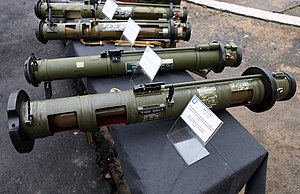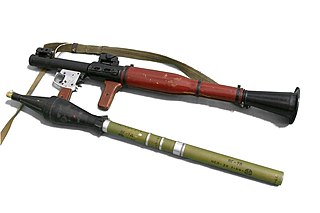
A rocket-propelled grenade (RPG) is a shoulder-fired rocket weapon that launches rockets equipped with an explosive warhead. Most RPGs can be carried by an individual soldier, and are frequently used as anti-tank weapons. These warheads are affixed to a rocket motor which propels the RPG towards the target and they are stabilized in flight with fins. Some types of RPG are reloadable with new rocket-propelled grenades, while others are single-use. RPGs are generally loaded from the front.
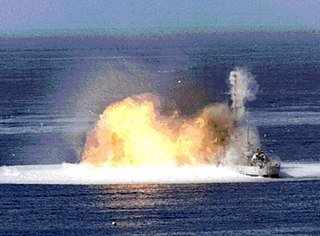
A thermobaric weapon, also called an aerosol bomb, or a vacuum bomb, is a type of explosive munition that works by dispersing an aerosol cloud of gas, liquid or powdered explosive. The fuel is usually a single compound, rather than a mixture of multiple molecules. Many types of thermobaric weapons can be fitted to hand-held launchers, and can also be launched from airplanes.

The Panzerfaust was a development family of single-shot man-portable anti-tank systems developed by Nazi Germany during World War II. The weapons were the first single-use light anti-tank weapons based on a pre-loaded disposable launch tube, a weapon configuration which is still used today.

The Carl Gustaf 8.4 cm recoilless rifle is a Swedish-developed 84 mm (3.3 in) caliber shoulder-fired recoilless rifle, initially developed by the Royal Swedish Army Materiel Administration during the second half of the 1940s as a crew-served man-portable infantry support gun for close-range multi-role anti-armour, anti-personnel, battlefield illumination, smoke screening and marking fire, which has seen great export success around the globe and continues to be a popular multi-purpose support weapon in use by many nations. The Carl Gustaf 84 mm recoilless rifle is a lightweight, low-cost weapon that uses a wide range of ammunition, which makes it extremely flexible and suitable for a wide variety of roles.

The RPG-7 is a portable, reusable, unguided, shoulder-launched, anti-tank, rocket launcher. The RPG-7 and its predecessor, the RPG-2, were designed by the Soviet Union, and are now manufactured by the Russian company Bazalt. The weapon has the GRAU index 6G3.

The M72 LAW is a portable one-shot 66 mm (2.6 in) unguided anti-tank weapon. The solid rocket propulsion unit was developed in the newly-formed Rohm and Haas research laboratory at Redstone Arsenal in 1959, and the full system was designed by Paul V. Choate, Charles B. Weeks, Frank A. Spinale, et al. at the Hesse-Eastern Division of Norris Thermador. American production of the weapon began by Hesse-Eastern in 1963, and was terminated by 1983; currently it is produced by Nammo Raufoss AS in Norway and their subsidiary, Nammo Defense Systems in Arizona.
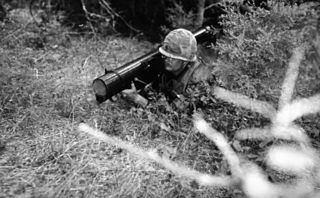
The LAW 80, regularly referred to as LAW 94 in British service, is a man-portable, disposable anti-tank weapon previously used by the British Army and a few other militaries.

The RPO-A Shmel is a man-portable, single-use, rocket-assisted thermobaric weapon. While its name directly translates to flamethrower, the RPO-A Shmel is more accurately described as a thermobaric weapon. The Shmel is designed, produced and exported by the Russian Federation and previously by the Soviet Union. It entered service with the Soviet Armed Forces at the end of the 1980s as the successor for the RPO Rys.

The RPG-26 Aglen is a disposable anti-tank rocket-propelled grenade (RPG) launcher developed by the Soviet Union. It fires a one-stage rocket with jack-knife fins, which unfold after launch. The rocket carries a 72.5-millimetre (2.85 in) diameter high-explosive anti-tank (HEAT) single shaped charge warhead able to penetrate 440 millimetres (17 in) of armour, 1 metre of reinforced concrete or 1.5 metres of brickwork. It has a maximum effective range of around 250 metres (820 ft). The similar sized rocket features a slightly heavier and more powerful HEAT warhead and more powerful rocket engine. The limited extension of the RPG-22 launch tube was found of little use. Thus, the RPG-26 has a rigid non-telescoping launch tube.
The RPG-27 is a Soviet single shot disposable rocket-propelled grenade (RPG) shoulder-fired missile and rocket launcher. It entered service with the Soviet Army in 1989.
The Panzerfaust 3 is a modern semi-disposable recoilless anti-tank weapon, which was developed between 1978 and 1985 and first entered service with the Bundeswehr in 1987. It was first ordered in 1973 to provide West German infantry with an effective weapon against contemporary Soviet armor, thereby replacing West Germany's aging PzF 44 Light Lanze launchers and the heavy Carl Gustaf 84 mm anti-tank recoilless rifle manufactured in Sweden.

RKG-3 is a series of Soviet anti-tank hand grenades. It superseded the RPG-43, RPG-40 and RPG-6 series, entering service in 1950. It was widely used in the 1973 Arab–Israeli War and remained a common weapon into the 2000s and early 2010s, being favoured by Iraqi insurgents during the American-led occupation. Modified versions of the RKG-3 series have also emerged in the Russian invasion of Ukraine.
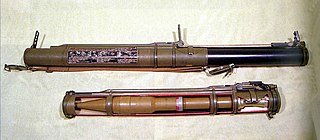
The RPG-18 Mukha is a Soviet short-range, disposable light anti-tank rocket launcher designed in 1972. It was based on the M72 LAW.
The RPG-16 is a handheld anti-tank grenade launcher for anti-tank warfare. It was developed in 1968 and adopted by the Soviet Army in 1970 for special operation teams and the Soviet airborne troops (VDV). These were deployed during the Soviet–Afghan War (1979–1989) and saw service during several battles in that conflict.

The Soviet RPG-22Netto is a one-shot disposable anti-tank rocket launcher first deployed in 1985, based on the RPG-18 rocket launcher, but firing a larger 72.5 mm fin stabilised projectile. The weapon fires an unguided projectile, can be prepared to fire in around 10 seconds, and can penetrate 400 mm of armour, 1.2 metres of brick or 1 metre of reinforced concrete.

The RPG-75 is a portable, disposable, single-shot anti-tank weapon, developed in the 1970s in Czechoslovakia. It fires a 68 mm grenade with an effective range of 300 meters and maximum range of 1000 meters. It resembles the American M72 LAW rocket launcher. This recoilless rifle is recommended to be used against light tanks and armoured tracked vehicles.

The RPG-30 "Kryuk" is a Russian hand-held disposable anti-tank grenade launcher.
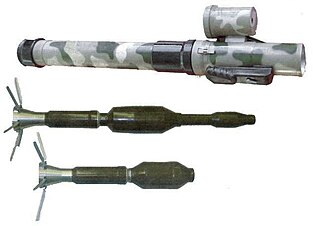
The RPG-32 Barkas is a reusable Russian shoulder-launched, unguided anti-tank rocket system. It was designed and developed by state-owned Unitary enterprise (FGUP) "Bazalt" weapon manufacturing company. It is also assembled in Jordan from Russian-made kits from Bazalt under the name "Nashshab".
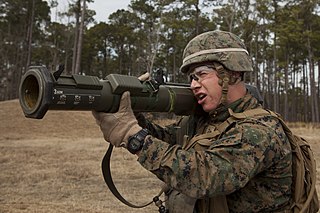
The AT4 is a Swedish 84 mm (3.31 in) unguided, man-portable, disposable, shoulder-fired recoilless anti-tank weapon manufactured by Saab Bofors Dynamics. The AT4 is not a rocket launcher strictly speaking, because the explosive warhead is not propelled by a rocket motor. Rather, it is a smooth-bore recoilless gun. Saab has had considerable sales success with the AT4, making it one of the most common light anti-tank weapons in the world. The M136 AT4 is a variant used by the United States Army.
The FT5 is a shoulder-launched, unguided and portable anti-tank rocket weapon. The weapon was built in South Africa by Somchem, a division of Denel based in Somerset West, now Rheinmetall Denel Munition. The weapon was designed with the primary function to provide soldiers with a weapon capable of destroying armoured fighting vehicles and modern main battle tanks. The weapon also has a secondary function of destroying bunkers and other fortifications.
